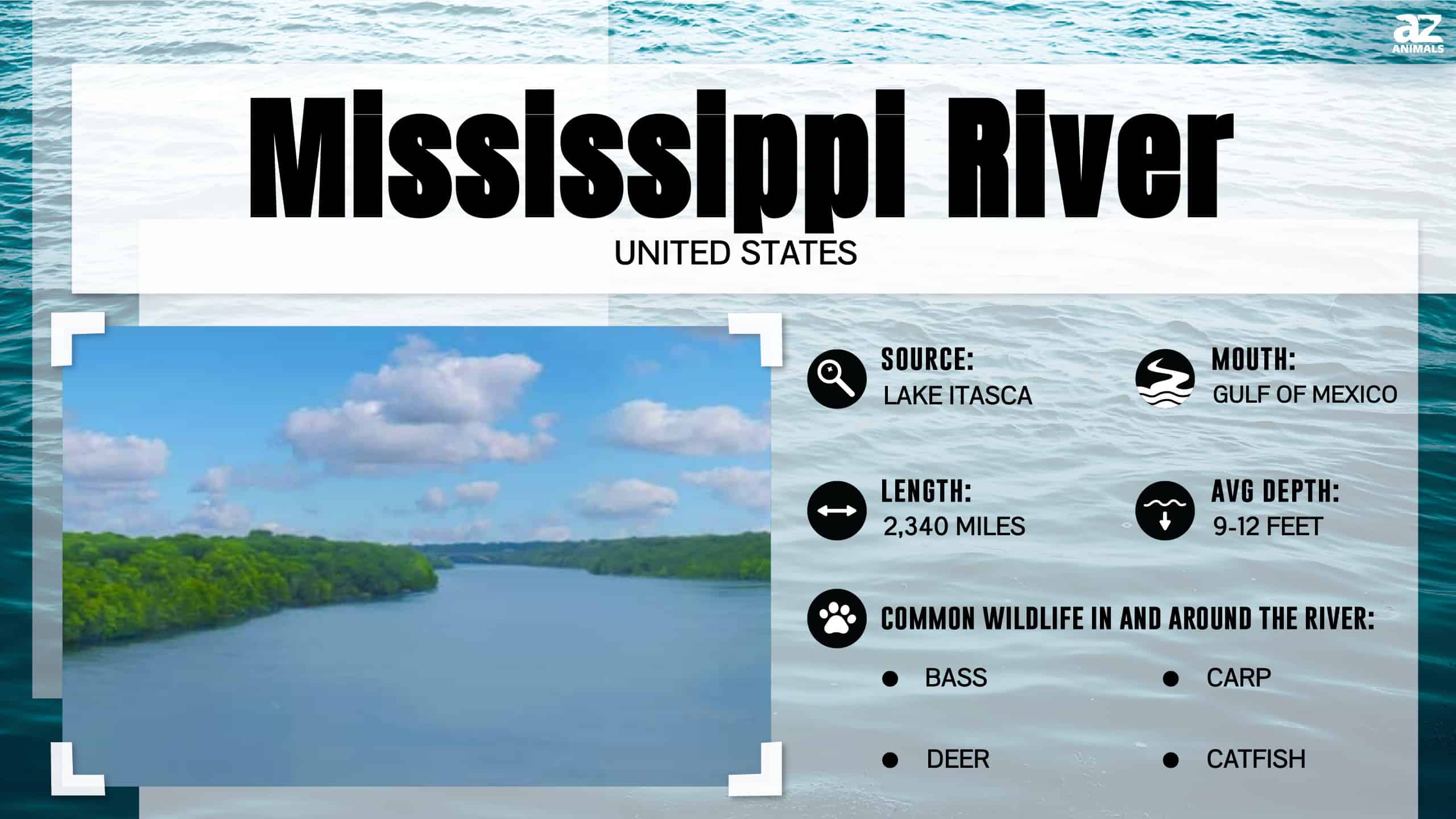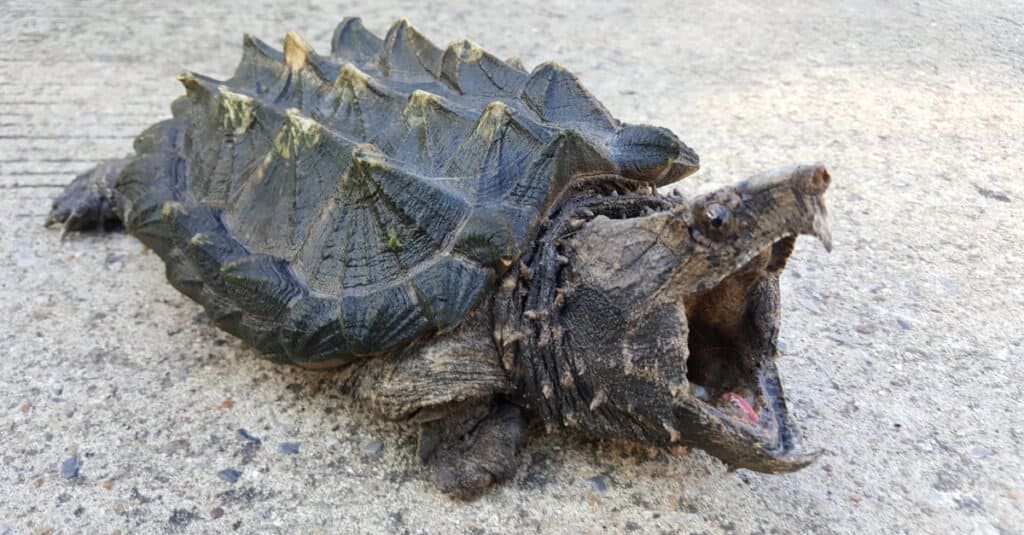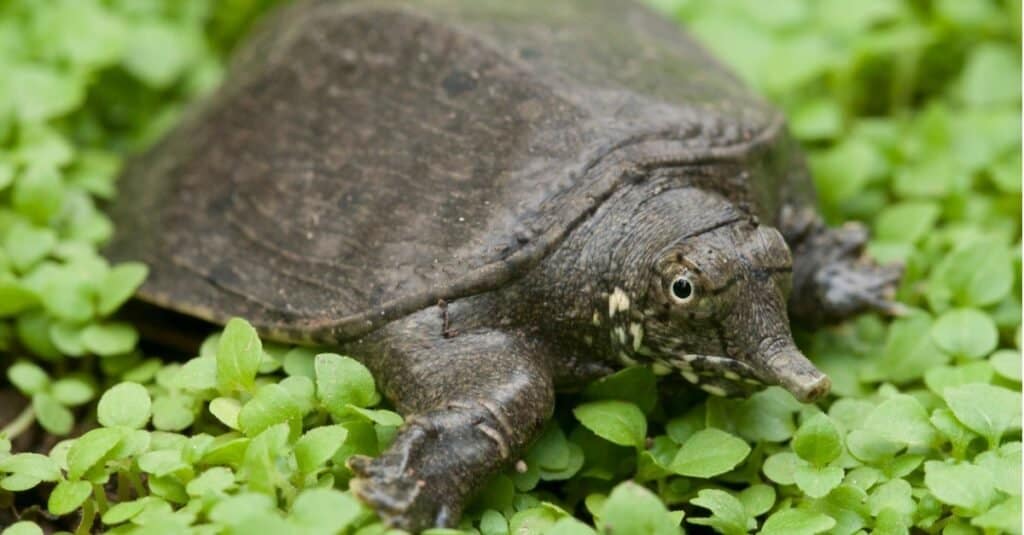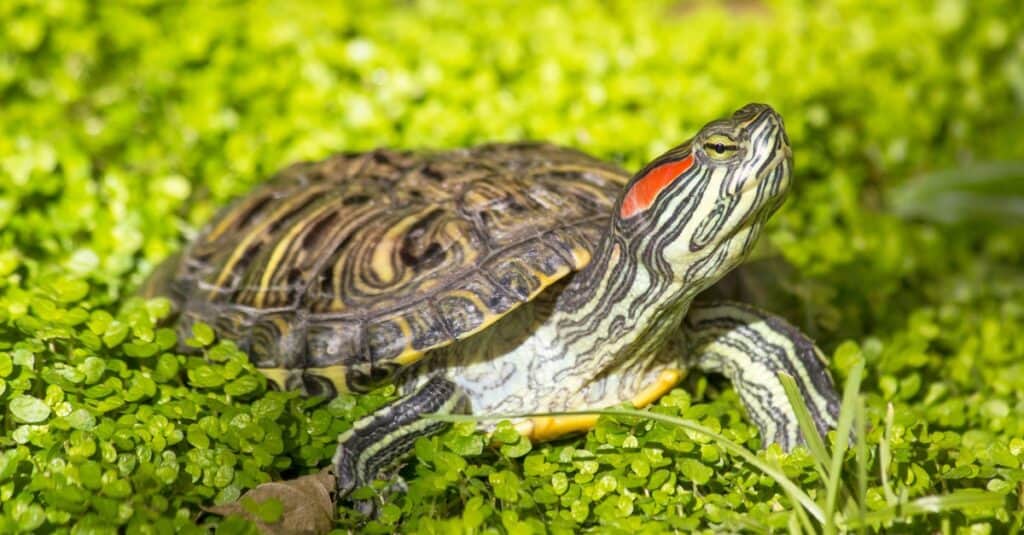The Mississippi River starts at a small lake in Minnesota (Lake Itasca) and travels 2,340 miles down the middle of the US to Louisiana where it empties into the Gulf of Mexico. Imagine all the fish and waterfowl that call the Mississippi their home. What about all of the turtles that live in the Mississippi? Are there any snapping turtles? Colorful painted turtles? How big is the biggest turtle? What turtles live in (and near) the Mississippi River?

Snapping Turtles

These large turtles can be covered with mud and algae. Watch out for their snapping beaks!
©Patrick Rolands/Shutterstock.com
The snapping turtle is one of the most common turtles in the Midwest and can be found in lakes, ponds, swamps, marshes, and rivers. You don’t want to find out the hard way why they call them snapping turtles! They have a sharp hooked beak that they are not afraid to use to snap and bite with a fierce bite, especially the alligator snapping turtle.

Alligator Snapping Turtles are the largest freshwater turtle in the world! Look at that sharp beak.
©Sista Vongjintanaruks/Shutterstock.com
- Alligator Snapping Turtle: These are the largest freshwater turtles in the world! Their shells can get to be 2 feet long! Most are 15-26 inches long and weigh 35-150 pounds. The heaviest alligator snapping turtle was 219 pounds. They have dark brown shells with jagged edges and a large head. Watch out for the sharp snapping beak.
- Eastern Snapping Turtle: The smaller Eastern snapping turtle is sometimes called the common snapping turtle. They are around 8-12 inches long and weigh 10-30 pounds. Their shells are brown or grey but may be covered in algae or mud since they spend most of their time in and around the water. This is why the Mississippi River is such a wonderful habitat for them.
Map Turtles
Map turtles are smaller than snapping turtles and have a black head with yellow markings. They are called map turtles because the markings on their shells look like a road map of sorts. They prefer living in the backwaters of rivers and tributaries so you can find them all along the Mississippi River.

Northern Map Turtle sunbathing on a floating log. They get their name from the map-like design on their shells.
©RLS Photo/Shutterstock.com
- False Map Turtle: 3 ½-10 ½ inches long, light brown shell with yellow and orange lines
- Mississippi Map Turtle: 6-10 inches long, head has slightly different pattern, likes to bask in the sun on logs near the river
- Ouachita Map Turtle: 6-10 inches long, similar look as the Mississippi Map turtle but the yellow markings around the eyes are much larger and it has two yellow circles under each eye
- Northern Map Turtle: 7-10 inches long, females have larger heads, shell is brown to olive with yellow lines on it
Painted Turtles

These are one of the most common turtles that live in and near the Mississippi River.
©KARI K/Shutterstock.com
Painted turtles may be the turtle that first comes to mind when you hear the word turtle. These are the ones you may pull over for and help get across the road. They have an olive to dark olive shell with bright orange around the edge and their bellies are bright yellow. Their heads are black with yellow lines with yellow ovals behind each eye. They have a short pointed tail.
- Midland Painted Turtle: 4 ½ -5 ½ inches long,they eat both vegetation and other animals like crayfish, insects and snails
- Western Painted Turtle: 5-7 inches, bigger than the Midland Painted and has a darker shell, prefers living in the backwaters
Softshell Turtles
Softshell turtles have a distinct look with a leathery shell that is actually soft. They are a large flat turtle that has a unique head as well, at least the snout. Their snout is long and skinny and at the end they have a pig-like snout! Their necks can extend quite long as well so they are quite the unique-looking animal.

Softshell turtles have a flat, leathery shell instead of a hard one. They have a very unique-looking nose.
©dwi putra stock/Shutterstock.com
- Spiny Softshell: 7-17 inches (females), 5-9 ½ inches (males), the most common softshell turtle, sharp bumps or spines are all around the edge of the upper shell, their shell has small bumps on it as well
- Midland Smooth Softshell: 7-14 inches (females), 5-7 inches (males), less common than the Spiny cousin and does not have any spines or bumps on its shell, a tad smaller as well
River Cooter
River cooters are big turtles with small heads. They are found mostly in the lower Mississippi and are not as common as some of the other turtles on our list. River cooters are 9-13 inches long and are dark brown or black with yellow line markings on the back. Their bellies are yellow and they have a dark head with yellow lines.
Eastern Musk Turtle

Eastern musk turtles are also called stinkpot turtles because they can emit a really foul smell!
©Ryan M. Bolton/Shutterstock.com
These are some of the tiniest turtles in the world. They have black shells and a head with yellow stripes. Eastern musk turtle adults get to be 3 ½ -4 ½ inches long. You probably want to know why they have the nickname “stinkpot turtle”. As a small turtle they have a lot of predators so they use their foul smell as a deterrent to predators, and do they ever smell. They don’t live further north than Dubuque, Iowa but can be found all along the Mississippi River.
Red-Eared Slider

Red-eared sliders have poor hearing but good vision and are very sensitive to vibrations.
©xbrchx/Shutterstock.com
The red-eared sliders get their name from the red spots on either side of their heads where ears would normally be. Turtles do not have ears but they do have a flap of skin that covers internal ear bones which help them detect sound. These turtles are common in the southern Midwest states. They grow to be 5-8 inches long and have a dark olive-brown shell with some yellow markings. They prefer slow-moving rivers, swamps and ponds.
Mississippi Diamondback Terrapin
The Mississippi diamondback terrapin can be found along the coastal area of Louisiana where the Mississippi empties into the Gulf of Mexico. Each scute on their shell has a raised diamond shape on it giving them their name. They grow to be 5-7 ½ inches long and prefer the brackish waters that have a mix of fresh and saltwater. Unlike their freshwater-only turtles they have built in glands that help them process salt water and can even live in saltwater for an extended amount of time. They are also adapted with webbed hind legs making them excellent swimmers.
From a colorful painted turtle you might find in Lake Itasca to a Mississippi Diamondback terrapin you might find at the end of the Mississippi, there are plenty of interesting turtles that live in (and near) the Mississippi River.
The photo featured at the top of this post is © Judy M Darby/Shutterstock.com
Thank you for reading! Have some feedback for us? Contact the AZ Animals editorial team.







